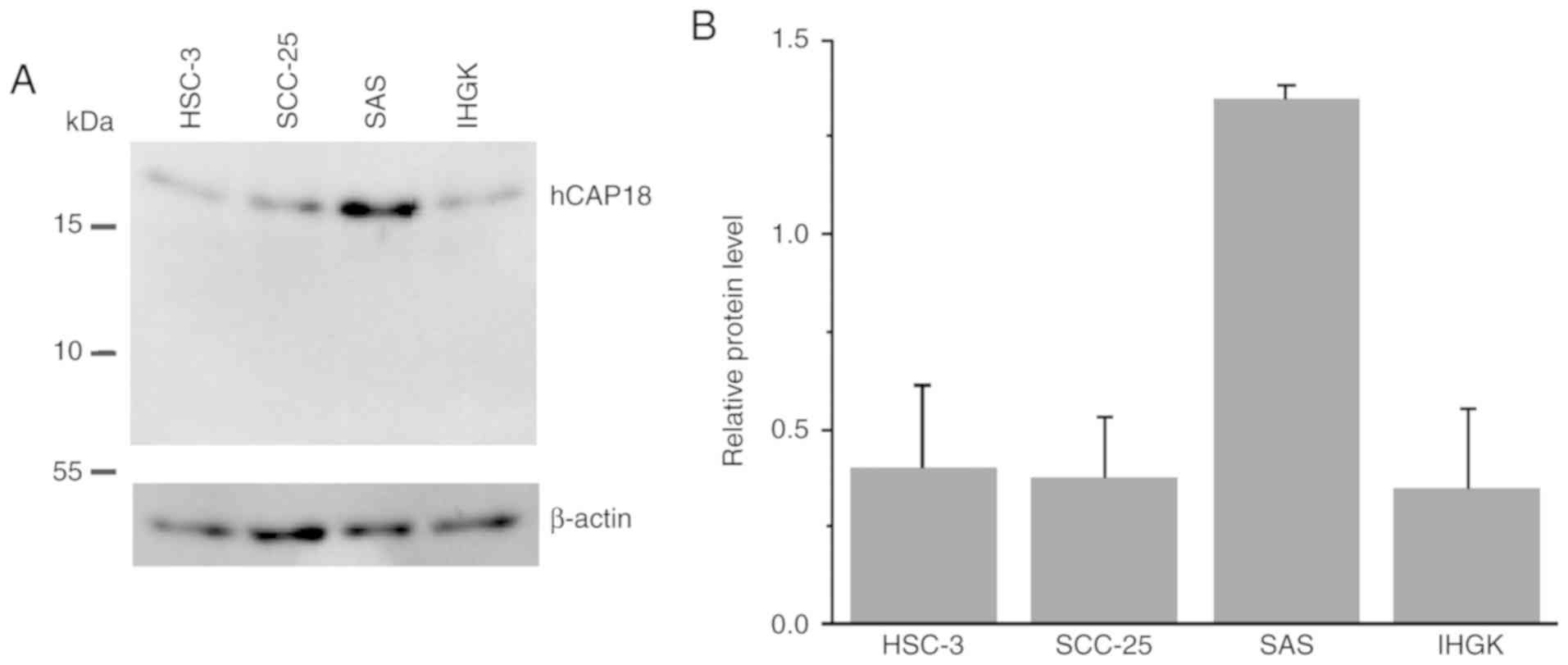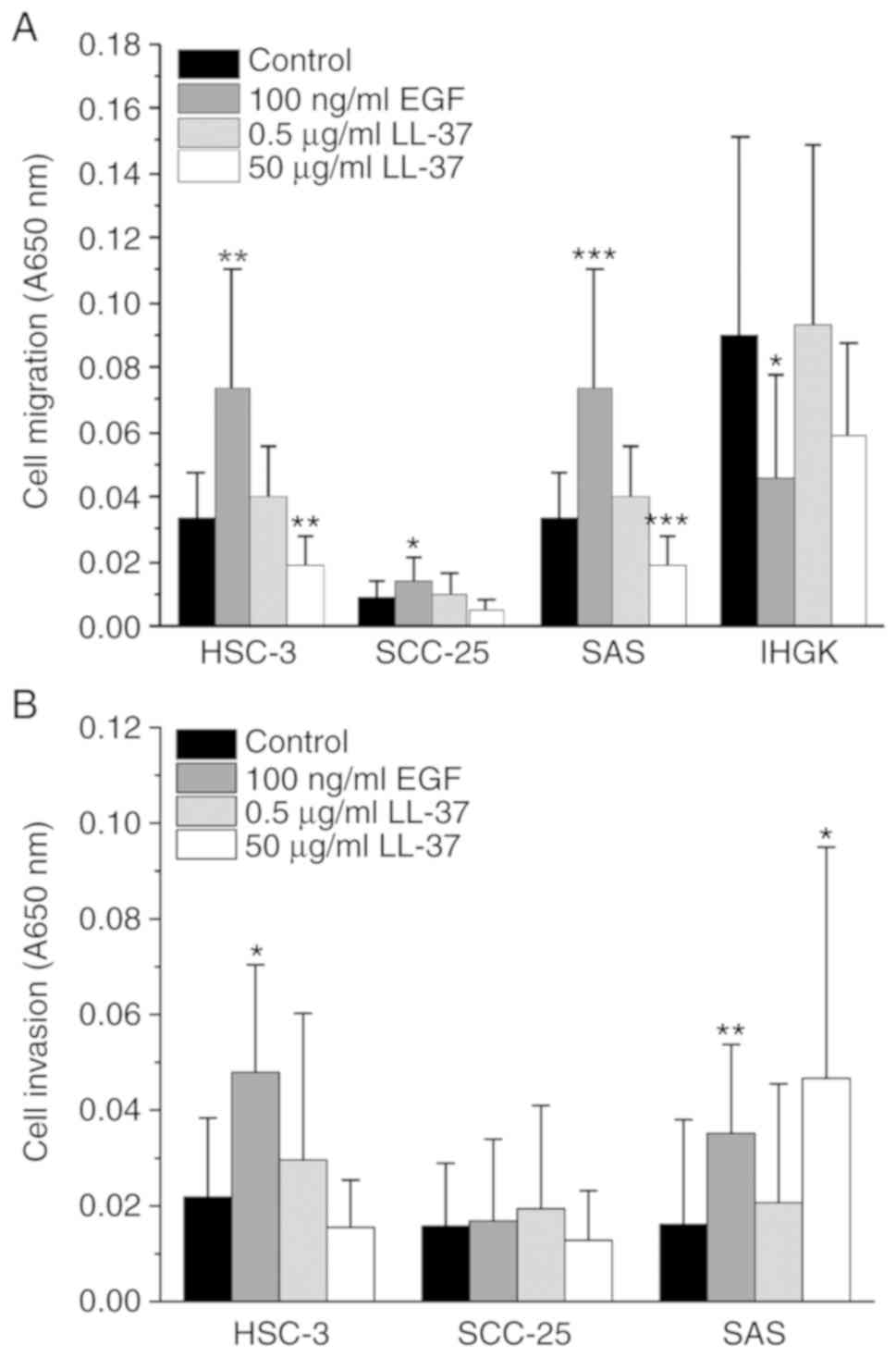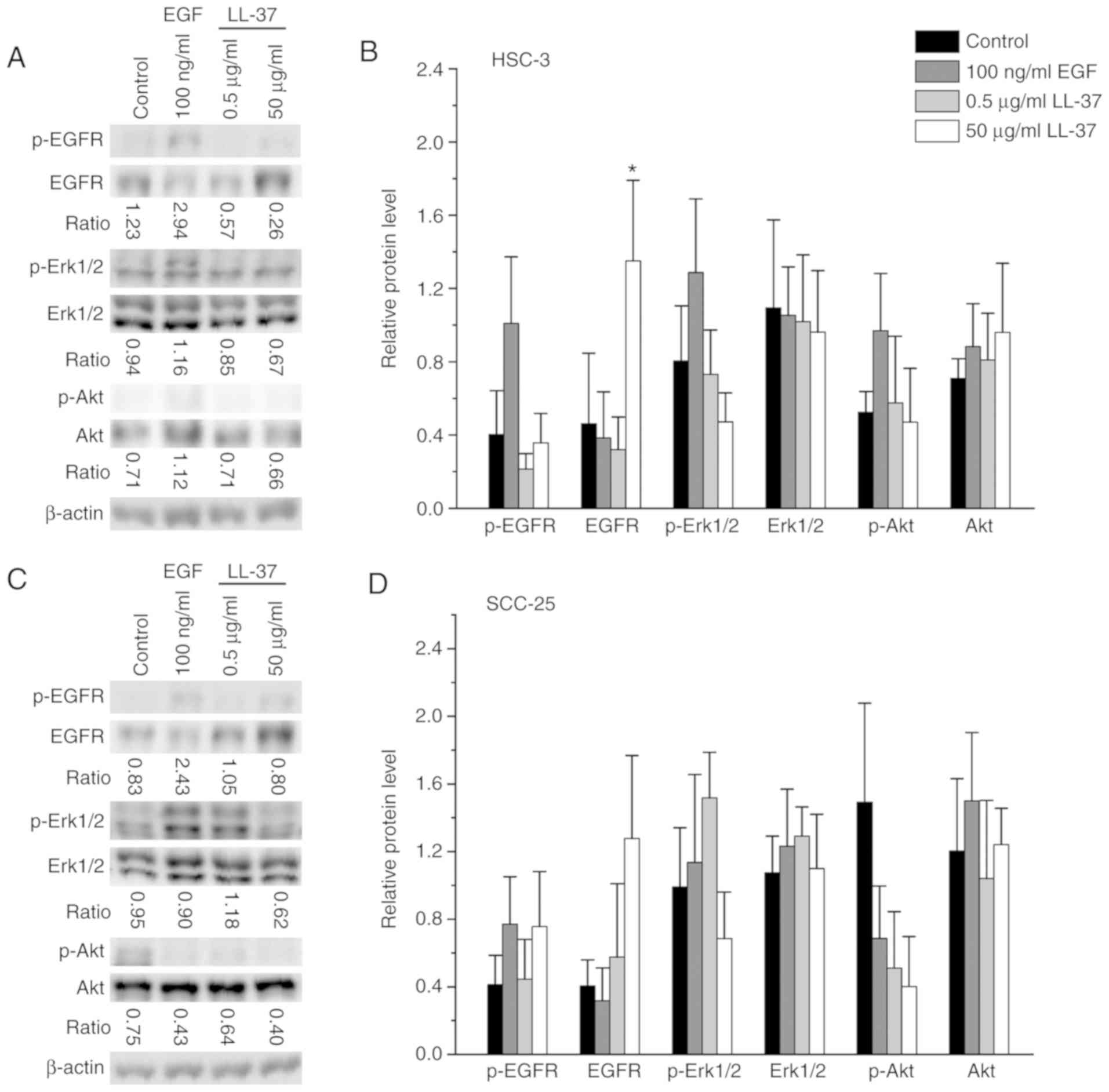Fluctuating role of antimicrobial peptide hCAP18/LL‑37 in oral tongue dysplasia and carcinoma
- Authors:
- Marlene Vierthaler
- Priscila Campioni Rodrigues
- Elias Sundquist
- Maria Siponen
- Tuula Salo
- Maija Risteli
-
Affiliations: Cancer Research and Translational Medicine Research Unit, Faculty of Medicine, University of Oulu, FI‑90014 Oulu, Finland, Institute of Dentistry, University of Eastern Finland, FI‑70211 Kuopio, Finland - Published online on: May 11, 2020 https://doi.org/10.3892/or.2020.7609
- Pages: 325-338
This article is mentioned in:
Abstract
 |
 |
 |
 |
 |
|
Annertz K, Anderson H, Palmér K and Wennerberg J: The increase in incidence of cancer of the tongue in the Nordic countries continues into the twenty-first century. Acta Otolaryngol. 132:552–557. 2012. View Article : Google Scholar : PubMed/NCBI | |
|
Patel SC, Carpenter WR, Tyree S, Couch ME, Weissler M, Hackman T, Hayes DN, Shores C and Chera BS: Increasing incidence of oral tongue squamous cell carcinoma in young white women, age 18 to 44 years. J Clin Oncol. 29:1488–1494. 2011. View Article : Google Scholar : PubMed/NCBI | |
|
Ng JH, Iyer NG, Tan MH and Edgren G: Changing epidemiology of oral squamous cell carcinoma of the tongue: A global study. Head Neck. 39:297–304. 2017. View Article : Google Scholar : PubMed/NCBI | |
|
Bray F, Ferlay J, Soerjomataram I, Siegel RL, Torre LA and Jemal A: Global cancer statistics 2018: GLOBOCAN estimates of incidence and mortality worldwide for 36 cancers in 185 countries. CA Cancer J Clin. 68:394–424. 2018. View Article : Google Scholar : PubMed/NCBI | |
|
Mroueh R, Haapaniemi A, Grénman R, Laranne J, Pukkila M, Almangush A, Salo T and Mäkitie A: Improved outcomes with oral tongue squamous cell carcinoma in Finland. Head Neck. 39:1306–1312. 2017. View Article : Google Scholar : PubMed/NCBI | |
|
Wu WK, Wang G, Coffelt SB, Betancourt AM, Lee CW, Fan D, Wu K, Yu J, Sung JJ and Cho CH: Emerging roles of the host defense peptide LL-37 in human cancer and its potential therapeutic applications. Int J Cancer. 127:1741–1747. 2010. View Article : Google Scholar : PubMed/NCBI | |
|
Piktel E, Niemirowicz K, Wnorowska U, Wątek M, Wollny T, Głuszek K, Góźdź S, Levental I and Bucki R: The role of cathelicidin LL-37 in cancer development. Arch Immunol Ther Exp (Warsz). 64:33–46. 2016. View Article : Google Scholar : PubMed/NCBI | |
|
Xhindoli D, Pacor S, Benincasa M, Scocchi M, Gennaro R and Tossi A: The human cathelicidin LL-37-A pore-forming antibacterial peptide and host-cell modulator. Biochim Biophys Acta. 1858:546–566. 2016. View Article : Google Scholar : PubMed/NCBI | |
|
Kuroda K, Okumura K, Isogai H and Isogai E: The human cathelicidin antimicrobial peptide LL-37 and mimics are potential anticancer drugs. Front Oncol. 5:1442015. View Article : Google Scholar : PubMed/NCBI | |
|
Verjans ET, Zels S, Luyten W, Landuyt B and Schoofs L: Molecular mechanisms of LL-37-induced receptor activation: An overview. Peptides. 85:16–26. 2016. View Article : Google Scholar : PubMed/NCBI | |
|
Sørensen OE, Follin P, Johnsen AH, Calafat J, Tjabringa GS, Hiemstra PS and Borregaard N: Human cathelicidin, hCAP-18, is processed to the antimicrobial peptide LL-37 by extracellular cleavage with proteinase 3. Blood. 97:3951–3959. 2001. View Article : Google Scholar : PubMed/NCBI | |
|
Yamasaki K, Schauber J, Coda A, Lin H, Dorschner RA, Schechter NM, Bonnart C, Descargues P, Hovnanian A and Gallo RL: Kallikrein-mediated proteolysis regulates the antimicrobial effects of cathelicidins in skin. FASEB J. 20:2068–2080. 2006. View Article : Google Scholar : PubMed/NCBI | |
|
Heilborn JD, Nilsson MF, Jimenez CIC, Sandstedt B, Borregaard N, Tham E, Sørensen OE, Weber G and Ståhle M: Antimicrobial protein hCAP18/LL-37 is highly expressed in breast cancer and is a putative growth factor for epithelial cells. Int J Cancer. 114:713–719. 2005. View Article : Google Scholar : PubMed/NCBI | |
|
Coffelt SB, Waterman RS, Florez L, Höner zu Bentrup K, Zwezdaryk KJ, Tomchuck SL, LaMarca HL, Danka ES, Morris CA and Scandurro AB: Ovarian cancers overexpress the antimicrobial protein hCAP-18 and its derivative LL-37 increases ovarian cancer cell proliferation and invasion. Int J Cancer. 122:1030–1039. 2008. View Article : Google Scholar : PubMed/NCBI | |
|
von Haussen J, Koczulla R, Shaykhiev R, Herr C, Pinkenburg O, Reimer D, Wiewrodt R, Biesterfeld S, Aigner A, Czubayko F and Bals R: The host defence peptide LL-37/hCAP-18 is a growth factor for lung cancer cells. Lung Cancer. 59:12–23. 2008. View Article : Google Scholar : PubMed/NCBI | |
|
Kim JE, Kim HJ, Choi JM, Lee KH, Kim TY, Cho BK, Jung JY, Chung KY, Cho D and Park HJ: The antimicrobial peptide human cationic antimicrobial protein-18/cathelicidin LL-37 as a putative growth factor for malignant melanoma. Br J Dermatol. 163:959–967. 2010. View Article : Google Scholar : PubMed/NCBI | |
|
Hensel JA, Chanda D, Kumar S, Sawant A, Grizzle WE, Siegal GP and Ponnazhagan S: LL-37 as a therapeutic target for late stage prostate cancer. Prostate. 71:659–670. 2011. View Article : Google Scholar : PubMed/NCBI | |
|
Sainz B Jr, Alcala S, Garcia E, Sanchez-Ripoll Y, Azevedo MM, Cioffi M, Tatari M, Miranda-Lorenzo I, Hidalgo M, Gomez-Lopez G, et al: Microenvironmental hCAP-18/LL-37 promotes pancreatic ductal adenocarcinoma by activating its cancer stem cell compartment. Gut. 64:1921–1935. 2015. View Article : Google Scholar : PubMed/NCBI | |
|
Hase K, Murakami M, Iimura M, Cole SP, Horibe Y, Ohtake T, Obonyo M, Gallo RL, Eckmann L and Kagnoff MF: Expression of LL-37 by human gastric epithelial cells as a potential host defense mechanism against Helicobacter pylori. Gastroenterology. 125:1613–1625. 2003. View Article : Google Scholar : PubMed/NCBI | |
|
An LL, Ma XT, Yang YH, Lin YM, Song YH and Wu KF: Marked reduction of LL-37/hCAP-18, an antimicrobial peptide, in patients with acute myeloid leukemia. Int J Hematol. 81:45–47. 2005. View Article : Google Scholar : PubMed/NCBI | |
|
Chen X, Qi G, Qin M, Zou Y, Zhong K, Tang Y, Guo Y, Jiang X, Liang L and Zou X: DNA methylation directly downregulates human cathelicidin antimicrobial peptide gene (CAMP) promoter activity. Oncotarget. 8:27943–27952. 2017. View Article : Google Scholar : PubMed/NCBI | |
|
Coffelt SB, Tomchuck SL, Zwezdaryk KJ, Danka ES and Scandurro AB: Leucine leucine-37 uses formyl peptide receptor-like 1 to activate signal transduction pathways, stimulate oncogenic gene expression, and enhance the invasiveness of ovarian cancer cells. Mol Cancer Res. 7:907–915. 2009. View Article : Google Scholar : PubMed/NCBI | |
|
Li Y, Cai L, Wang H, Wu P, Gu W, Chen Y, Hao H, Tang K, Yi P, Liu M, et al: Pleiotropic regulation of macrophage polarization and tumorigenesis by formyl peptide receptor-2. Oncogene. 30:3887–3899. 2011. View Article : Google Scholar : PubMed/NCBI | |
|
De Yang D, Chen Q, Schmidt AP, Anderson GM, Wang JM, Wooters J, Oppenheim JJ and Chertov O: LL-37, the neutrophil granule- and epithelial cell-derived cathelicidin, utilizes formyl peptide receptor-like 1 (FPRL1) as a receptor to chemoattract human peripheral blood neutrophils, monocytes, and T cells. J Exp Med. 192:1069–1074. 2000. View Article : Google Scholar : PubMed/NCBI | |
|
Weber G, Chamorro CI, Granath F, Liljegren A, Zreika S, Saidak Z, Sandstedt B, Rotstein S, Mentaverri R, Sánchez F, et al: Human antimicrobial protein hCAP18/LL-37 promotes a metastatic phenotype in breast cancer. Breast Cancer Res. 11:R62009. View Article : Google Scholar : PubMed/NCBI | |
|
Tjabringa GS, Aarbiou J, Ninaber DK, Drijfhout JW, Sørensen OE, Borregaard N, Rabe KF and Hiemstra PS: The antimicrobial peptide LL-37 activates innate immunity at the airway epithelial surface by transactivation of the epidermal growth factor receptor. J Immunol. 171:6690–6696. 2003. View Article : Google Scholar : PubMed/NCBI | |
|
Tokumaru S, Sayama K, Shirakata Y, Komatsuzawa H, Ouhara K, Hanakawa Y, Yahata Y, Dai X, Tohyama M, Nagai H, et al: Induction of keratinocyte migration via transactivation of the epidermal growth factor receptor by the antimicrobial peptide LL-37. J Immunol. 175:4662–4668. 2005. View Article : Google Scholar : PubMed/NCBI | |
|
Frohm Nilsson M, Sandstedt B, Sørensen O, Weber G, Borregaard N and Ståhle-Bäckdahl M: The human cationic antimicrobial protein (hCAP18), a peptide antibiotic, is widely expressed in human squamous epithelia and colocalizes with interleukin-6. Infect Immun. 67:2561–2566. 1999. View Article : Google Scholar : PubMed/NCBI | |
|
Khurshid Z, Naseem M, Yahya I Asiri F, Mali M, Sannam Khan R, Sahibzada HA, Zafar MS, Faraz Moin S and Khan E: Significance and diagnostic role of antimicrobial cathelicidins (LL-37) peptides in oral health. Biomolecules. 7(pii): E802017. View Article : Google Scholar : PubMed/NCBI | |
|
Oda D, Bigler L, Mao EJ and Disteche CM: Chromosomal abnormalities in HPV-16-immortalized oral epithelial cells. Carcinogenesis. 17:2003–2008. 1996. View Article : Google Scholar : PubMed/NCBI | |
|
Salo T, Sutinen M, Hoque Apu E, Sundquist E, Cervigne NK, de Oliveira CE, Akram SU, Ohlmeier S, Suomi F, Eklund L, et al: A novel human leiomyoma tissue derived matrix for cell culture studies. BMC Cancer. 15:9812015. View Article : Google Scholar : PubMed/NCBI | |
|
Salo T, Dourado MR, Sundquist E, Apu EH, Alahuhta I, Tuomainen K, Vasara J and Al-Samadi A: Organotypic three-dimensional assays based on human leiomyoma-derived matrices. Philos Trans R Soc Lond B Biol Sci. 373(pii): 201604822018. View Article : Google Scholar : PubMed/NCBI | |
|
Schindelin J, Arganda-Carreras I, Frise E, Kaynig V, Longair M, Pietzsch T, Preibisch S, Rueden C, Saalfeld S, Schmid B, et al: Fiji: An open-source platform for biological-image analysis. Nat Methods. 9:676–682. 2012. View Article : Google Scholar : PubMed/NCBI | |
|
Nyberg P, Heikkilä P, Sorsa T, Luostarinen J, Heljasvaara R, Stenman UH, Pihlajaniemi T and Salo T: Endostatin inhibits human tongue carcinoma cell invasion and intravasation and blocks the activation of matrix metalloprotease-2, −9, and −13. J Biol Chem. 278:22404–22411. 2003. View Article : Google Scholar : PubMed/NCBI | |
|
Sundquist E, Kauppila JH, Veijola J, Mroueh R, Lehenkari P, Laitinen S, Risteli J, Soini Y, Kosma VM, Sawazaki-Calone I, et al: Tenascin-C and fibronectin expression divide early stage tongue cancer into low- and high-risk groups. Br J Cancer. 116:640–648. 2017. View Article : Google Scholar : PubMed/NCBI | |
|
Wang W, Zheng Y, Jia J, Li C, Duan Q, Li R, Wang X, Shao Y, Chen C and Yan H: Antimicrobial peptide LL-37 promotes the viability and invasion of skin squamous cell carcinoma by upregulating YB-1. Exp Ther Med. 14:499–506. 2017. View Article : Google Scholar : PubMed/NCBI | |
|
Wang W, Jia J, Li C, Duan Q, Yang J, Wang X, Li R, Chen C, Yan H and Zheng Y: Antimicrobial peptide LL-37 promotes the proliferation and invasion of skin squamous cell carcinoma by upregulating DNA-binding protein A. Oncol Lett. 12:1745–1752. 2016. View Article : Google Scholar : PubMed/NCBI | |
|
Jia J, Zheng Y, Wang W, Shao Y, Li Z, Wang Q, Wang Y and Yan H: Antimicrobial peptide LL-37 promotes YB-1 expression, and the viability, migration and invasion of malignant melanoma cells. Mol Med Rep. 15:240–248. 2017. View Article : Google Scholar : PubMed/NCBI | |
|
Wu WK, Sung JJ, To KF, Yu L, Li HT, Li ZJ, Chu KM, Yu J and Cho CH: The host defense peptide LL-37 activates the tumor-suppressing bone morphogenetic protein signaling via inhibition of proteasome in gastric cancer cells. J Cell Physiol. 223:178–186. 2010.PubMed/NCBI | |
|
Ren SX, Cheng AS, To KF, Tong JH, Li MS, Shen J, Wong CC, Zhang L, Chan RL, Wang XJ, et al: Host immune defense peptide LL-37 activates caspase-independent apoptosis and suppresses colon cancer. Cancer Res. 72:6512–6523. 2012. View Article : Google Scholar : PubMed/NCBI | |
|
Li D, Liu W, Wang X, Wu J, Quan W, Yao Y, Bals R, Ji S, Wu K, Guo J and Wan H: Cathelicidin, an antimicrobial peptide produced by macrophages, promotes colon cancer by activating the Wnt/β-catenin pathway. Oncotarget. 6:2939–2950. 2015. View Article : Google Scholar : PubMed/NCBI | |
|
Okumura K, Itoh A, Isogai E, Hirose K, Hosokawa Y, Abiko Y, Shibata T, Hirata M and Isogai H: C-terminal domain of human CAP18 antimicrobial peptide induces apoptosis in oral squamous cell carcinoma SAS-H1 cells. Cancer Lett. 212:185–194. 2004. View Article : Google Scholar : PubMed/NCBI | |
|
Shaykhiev R, Beisswenger C, Kändler K, Senske J, Püchner A, Damm T, Behr J and Bals R: Human endogenous antibiotic LL-37 stimulates airway epithelial cell proliferation and wound closure. Am J Physiol Lung Cell Mol Physiol. 289:L842–L848. 2005. View Article : Google Scholar : PubMed/NCBI | |
|
Kamata N, Chida K, Rikimaru K, Horikoshi M, Enomoto S and Kuroki T: Growth-inhibitory effects of epidermal growth factor and overexpression of its receptors on human squamous cell carcinomas in culture. Cancer Res. 46:1648–1653. 1986.PubMed/NCBI | |
|
Momose F, Araida T, Negishi A, Ichijo H, Shioda S and Sasaki S: Variant sublines with different metastatic potentials selected in nude mice from human oral squamous cell carcinomas. J Oral Pathol Med. 18:391–395. 1989. View Article : Google Scholar : PubMed/NCBI | |
|
Matsumoto K, Matsumoto K, Nakamura T and Kramer RH: Hepatocyte growth factor/scatter factor induces tyrosine phosphorylation of focal adhesion kinase (p125FAK) and promotes migration and invasion by oral squamous cell carcinoma cells. J Biol Chem. 269:31807–31813. 1994.PubMed/NCBI | |
|
Ramos DM, Chen BL, Boylen K, Stern M, Kramer RH, Sheppard D, Nishimura SL, Greenspan D, Zardi L and Pytela R: Stromal fibroblasts influence oral squamous-cell carcinoma cell interactions with tenascin-C. Int J Cancer. 72:369–376. 1997. View Article : Google Scholar : PubMed/NCBI | |
|
Okumura K, Konishi A, Tanaka M, Kanazawa M, Kogawa K and Niitsu Y: Establishment of high- and low-invasion clones derived for a human tongue squamous-cell carcinoma cell line SAS. J Cancer Res Clin Oncol. 122:243–248. 1996. View Article : Google Scholar : PubMed/NCBI | |
|
Takahashi K, Kanazawa H, Akiyama Y, Tazaki S, Takahara M, Muto T, Tanzawa H, Sato KI, Akiyama T, MUTO T, et al: Establishment and characterization of a cell line (SAS) from poorly differentiated human squamous cell carcinoma of the tongue. J Jpn Stomatol Soc. 38:20–28. 1989. | |
|
Yin J and Yu FS: LL-37 via EGFR transactivation to promote high glucose-attenuated epithelial wound healing in organ-cultured corneas. Invest Ophthalmol Vis Sci. 51:1891–1897. 2010. View Article : Google Scholar : PubMed/NCBI | |
|
Ribeiro FA, Noguti J, Oshima CT and Ribeiro DA: Effective targeting of the epidermal growth factor receptor (EGFR) for treating oral cancer: A promising approach. Anticancer Res. 34:1547–1552. 2014.PubMed/NCBI | |
|
Cheng M, Ho S, Yoo JH, Tran DH, Bakirtzi K, Su B, Tran DH, Kubota Y, Ichikawa R and Koon HW: Cathelicidin suppresses colon cancer development by inhibition of cancer associated fibroblasts. Clin Exp Gastroenterol. 8:13–29. 2014.PubMed/NCBI | |
|
Carretero M, Escámez MJ, García M, Duarte B, Holguín A, Retamosa L, Jorcano JL, Río MD and Larcher F: In vitro and in vivo wound healing-promoting activities of human cathelicidin LL-37. J Invest Dermatol. 128:223–236. 2008. View Article : Google Scholar : PubMed/NCBI | |
|
Smith A, Teknos TN and Pan Q: Epithelial to mesenchymal transition in head and neck squamous cell carcinoma. Oral Oncol. 49:287–292. 2013. View Article : Google Scholar : PubMed/NCBI | |
|
Braff MH, Di Nardo A and Gallo RL: Keratinocytes store the antimicrobial peptide cathelicidin in lamellar bodies. J Invest Dermatol. 124:394–400. 2005. View Article : Google Scholar : PubMed/NCBI | |
|
Mader JS, Mookherjee N, Hancock REW and Bleackley RC: The human host defense peptide LL-37 induces apoptosis in a calpain- and apoptosis-inducing factor-dependent manner involving Bax activity. Mol Cancer Res. 7:689–702. 2009. View Article : Google Scholar : PubMed/NCBI | |
|
Açil Y, Torz K, Gülses A, Wieker H, Gerle M, Purcz N, Will OM, Eduard Meyer J and Wiltfang J: An experimental study on antitumoral effects of KI-21-3, a synthetic fragment of antimicrobial peptide LL-37, on oral squamous cell carcinoma. J Craniomaxillofac Surg. 46:1586–1592. 2018. View Article : Google Scholar : PubMed/NCBI | |
|
Sakai E and Tsuchida N: Most human squamous cell carcinomas in the oral cavity contain mutated p53 tumor-suppressor genes. Oncogene. 7:927–933. 1992.PubMed/NCBI | |
|
Min BM, Baek JH, Shin KH, Gujuluva CN, Cherrick HM and Park NH: Inactivation of the p53 gene by either mutation or HPV infection is extremely frequent in human oral squamous cell carcinoma cell lines. Eur J Cancer B Oral Oncol. 30B:338–345. 1994. View Article : Google Scholar : PubMed/NCBI | |
|
Kanata H, Yane K, Ota I, Miyahara H, Matsunaga T, Takahashi A, Ohnishi K, Ohnishi T and Hosoi H: CDDP induces p53-dependent apoptosis in tongue cancer cells. Int J Oncol. 17:513–517. 2000.PubMed/NCBI | |
|
Ohnishi K, Ota I, Takahashi A and Ohnishi T: Glycerol restores p53-dependent radiosensitivity of human head and neck cancer cells bearing mutant p53. Br J Cancer. 83:1735–1739. 2000. View Article : Google Scholar : PubMed/NCBI | |
|
Ratushny V, Astsaturov I, Burtness BA, Golemis EA and Silverman JS: Targeting EGFR resistance networks in head and neck cancer. Cell Signal. 21:1255–1268. 2009. View Article : Google Scholar : PubMed/NCBI | |
|
Meloche S and Pouysségur J: The ERK1/2 mitogen-activated protein kinase pathway as a master regulator of the G1- to S-phase transition. Oncogene. 26:3227–3239. 2007. View Article : Google Scholar : PubMed/NCBI | |
|
Qiao M, Sheng S and Pardee AB: Metastasis and AKT activation. Cell Cycle. 7:2991–2996. 2008. View Article : Google Scholar : PubMed/NCBI | |
|
Nijnik A, Pistolic J, Filewod NCJ and Hancock REW: Signaling pathways mediating chemokine induction in keratinocytes by cathelicidin LL-37 and flagellin. J Innate Immun. 4:377–386. 2012. View Article : Google Scholar : PubMed/NCBI |









